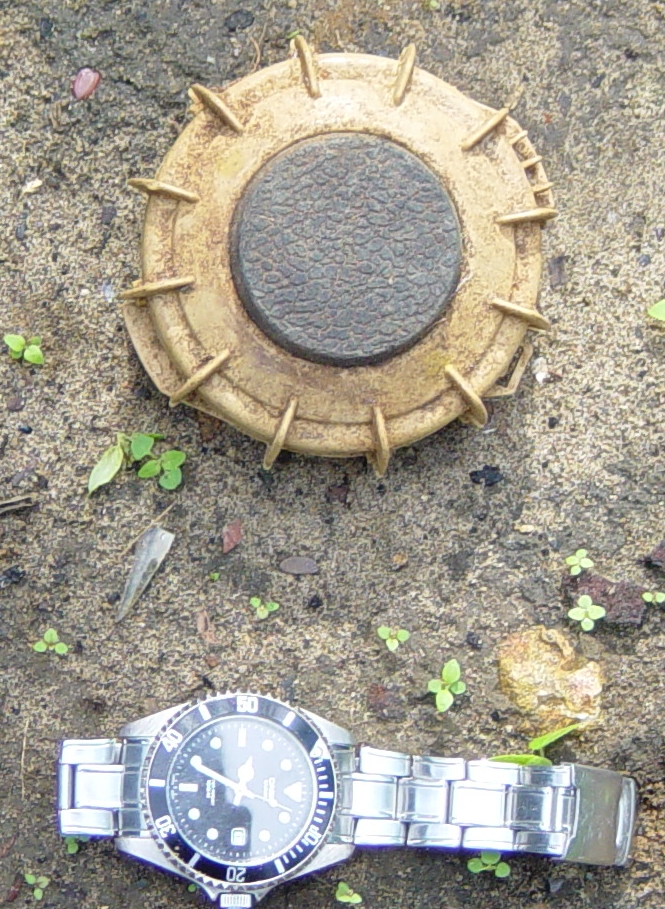|
PM-43 And PM-68 Mine
The PM-43 (Putkimiina m/43) and PM-68 (Putkimiina m/68) are Finnish anti-personnel fragmentation mines. The PM-43 has a long cylindrical steel body, with heavy fragmentation grooves. It has been used with variety of fuzes including the Model 43, VS-70, and US-65. Currently, it is used with the VS-86 tripwire fuze. The mine is normally mounted in a tree. The PM-68 is similar but uses a body formed from a tightly coiled spring, and currently uses a VS-91 fuze, although it can be used with any of the fuzes used with the PM-43. After Finland joined the Ottawa Treaty, the Finnish Defence Forces began a process to destroy the mines. The work was completed in 2015. Specifications * Diameter: 60 mm approx * Length: 180 mm approx * Weight: 2 kg * Explosive content: 0.18 kg consisting of three 0.06 kg cylindrical blocks of TNT Trinitrotoluene (), more commonly known as TNT, more specifically 2,4,6-trinitrotoluene, and by its preferred IUPAC name 2-methyl-1,3 ... [...More Info...] [...Related Items...] OR: [Wikipedia] [Google] [Baidu] |
Finland
Finland ( fi, Suomi ; sv, Finland ), officially the Republic of Finland (; ), is a Nordic country in Northern Europe. It shares land borders with Sweden to the northwest, Norway to the north, and Russia to the east, with the Gulf of Bothnia to the west and the Gulf of Finland across Estonia to the south. Finland covers an area of with a population of 5.6 million. Helsinki is the capital and largest city, forming a larger metropolitan area with the neighbouring cities of Espoo, Kauniainen, and Vantaa. The vast majority of the population are ethnic Finns. Finnish, alongside Swedish, are the official languages. Swedish is the native language of 5.2% of the population. Finland's climate varies from humid continental in the south to the boreal in the north. The land cover is primarily a boreal forest biome, with more than 180,000 recorded lakes. Finland was first inhabited around 9000 BC after the Last Glacial Period. The Stone Age introduced several differ ... [...More Info...] [...Related Items...] OR: [Wikipedia] [Google] [Baidu] |
Anti-personnel Mine
Anti-personnel mines are a form of mine designed for use against humans, as opposed to anti-tank mines, which are designed for use against vehicles. Anti-personnel mines may be classified into blast mines or fragmentation mines; the latter may or may not be a bounding mine. The mines are often designed to injure, not kill, their victims to increase the logistical (mostly medical) support required by enemy forces that encounter them. Some types of anti-personnel mines can also damage the tracks on armoured vehicles or the tires of wheeled vehicles. The International Campaign to Ban Landmines has sought to ban mines culminating in the 1997 Ottawa Treaty, although this treaty has not yet been accepted by over 30 countries. Use Anti-personnel mines are used in a similar manner to anti-tank mines, in static "mine fields" along national borders or in defense of strategic positions as described in greater detail in the land mine article. What makes them different from most anti-ta ... [...More Info...] [...Related Items...] OR: [Wikipedia] [Google] [Baidu] |
Model 43
''Stielhandgranate'' is the German term for " stick hand grenade" (translation: "shaft hand grenade") and generally refers to a prominent series of World War I and World War II-era German stick grenade designs, distinguished by their long wooden handles, pull cord arming and cylindrical warheads. The first models were introduced by the Imperial German Army during World War I and the final design was introduced during World War II by the German Wehrmacht. The distinctive appearance of the stielhandgranate-family has led to them being called " potato mashers" in British Army slang, and they remain one of the most easily recognized infantry weapons of the 20th century. World War I models: 1915–1917 Germany entered World War I with a single grenade type: a heavy ball-shaped fragmentation grenade (''Kugelhandgranate'') for use only by pioneers in attacking fortifications. It was too heavy for regular battlefield use by untrained troops and not suitable for mas ... [...More Info...] [...Related Items...] OR: [Wikipedia] [Google] [Baidu] |
VS-50 Mine
The VS-50 is a circular plastic-cased anti-personnel blast mine that entered production in 1985. It was formerly made by the now-defunct Valsella Meccanotecnica SpA, an Italian high-tech defence company specialized in area denial systems. The company also the made the Valmara 69, and was one of the first to implement plastic construction for landmines. The VS-50's design is similar to that of the TS-50 and VS-MK2 mines. It is blast resistant and can be used in a minimum metal configuration. Though unlikely to kill, its explosive charge is quite sufficient to destroy the victim's foot, being capable of penetrating 5 mm of mild steel leaving an 80 mm-diameter hole. Description The mine consists of three sections, a bottom section containing the main explosive charge, a middle section which contains the fuze and safety/arming mechanism, and the top section which consists of a neoprene pressure pad. The neoprene pressure pad is sometimes reinforced with an 18 gram mild s ... [...More Info...] [...Related Items...] OR: [Wikipedia] [Google] [Baidu] |
Ottawa Treaty
The Convention on the Prohibition of the Use, Stockpiling, Production and Transfer of Anti-Personnel Mines and on their Destruction of 1997, known informally as the Ottawa Treaty, the Anti-Personnel Mine Ban Convention, or often simply the Mine Ban Treaty, aims at eliminating anti-personnel mine, anti-personnel landmines (AP-mines) around the world. To date, there are 164 state parties to the treaty. One state (the Marshall Islands) has signed but not ratified the treaty, while List of parties to the Ottawa Treaty#Non-signatory states, 32 UN states, including China, Russia, and the United States have not; making a total of 33 United Nations states not party. Chronology Early action and draft Conventions 1994 self-imposed moratorium on sales of mines dated 15th March 1994 1995 legislation passed on the 3rd of March 1995 to ban the production and export of all landmines this decision was to be reviewed after 5 years ... [...More Info...] [...Related Items...] OR: [Wikipedia] [Google] [Baidu] |
Finnish Defence Forces
The Finnish Defence Forces ( fi, Puolustusvoimat, sv, Försvarsmakten) are the military of Finland. The Finnish Defence Forces consist of the Finnish Army, the Finnish Navy and the Finnish Air Force. In wartime the Finnish Border Guard (which is its own military unit in peacetime) becomes part of the Finnish Defence Forces. Universal male conscription is in place, under which all men serve for 165, 255, or 347 days, from the year they turn 18 until the year they turn 29. Alternative non-military service for men and voluntary service for women is available. Finland is the only non-NATO European Union state bordering Russia. Finland's official policy states that a wartime military strength of 280,000 personnel constitutes a sufficient deterrent. The army consists of a highly mobile field army backed up by local defence units. The army defends the national territory and its military strategy employs the use of the heavily forested terrain and numerous lakes to wear down an aggre ... [...More Info...] [...Related Items...] OR: [Wikipedia] [Google] [Baidu] |
Helsingin Sanomat
''Helsingin Sanomat'', abbreviated ''HS'' and colloquially known as , is the largest subscription newspaper in Finland and the Nordic countries, owned by Sanoma. Except after certain holidays, it is published daily. Its name derives from that of the Finnish capital, Helsinki, where it is published. It is considered a newspaper of record for Finland. History and profile The paper was founded in 1889 as ''Päivälehti'', when Finland was a Grand Duchy under the Tsar of Russia. Political censorship by the Russian authorities, prompted by the paper's strong advocacy of greater Finnish freedoms and even outright independence, forced Päivälehti to often temporarily suspend publication, and finally to close permanently in 1904. Its proprietors re-opened the paper under its current name in 1905. Founded as the organ of the Young Finnish Party, the paper has been politically independent and non-aligned since 1932. During the Cold War period ''Helsingin Sanomat'' was among the Finn ... [...More Info...] [...Related Items...] OR: [Wikipedia] [Google] [Baidu] |
Anti-personnel Mines
Anti-personnel mines are a form of mine designed for use against humans, as opposed to anti-tank mines, which are designed for use against vehicles. Anti-personnel mines may be classified into blast mines or fragmentation mines; the latter may or may not be a bounding mine. The mines are often designed to injure, not kill, their victims to increase the logistical (mostly medical) support required by enemy forces that encounter them. Some types of anti-personnel mines can also damage the tracks on armoured vehicles or the tires of wheeled vehicles. The International Campaign to Ban Landmines has sought to ban mines culminating in the 1997 Ottawa Treaty, although this treaty has not yet been accepted by over 30 countries. Use Anti-personnel mines are used in a similar manner to anti-tank mines, in static "mine fields" along national borders or in defense of strategic positions as described in greater detail in the land mine article. What makes them different from most anti-ta ... [...More Info...] [...Related Items...] OR: [Wikipedia] [Google] [Baidu] |

.jpg)

